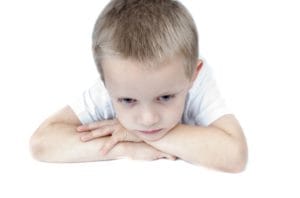It’s Not Personal, It’s a Chemical Reaction
Posted by Autumn Templeton on 4th Dec 2019
“I’m sorry, we just don’t see it in school.”
“Whatever is happening at home, it is not affecting her education.”
“He has lots of friends and is happy in class.”
Receiving positive feedback from teachers during conferences may have many parents perplexed about their student. It just doesn’t match what they witness at home. Each day, within the first half hour after arriving home from school, their kiddo would have an outburst or emotional breakdown. These after school meltdowns can be confusing when, overall, the understanding is that the child is happy during their school day. So what’s the deal!?! Now it feels personal! Don’t pull your hair out or threaten screen time just yet. In the famous words of Madonna, “It’s a chemical reaction.”

Adrenalin and cortisol keep children under control in environments where behavioral performance is important, in school, and flush out the individual’s system when the quality of performance is considered less important, at home. For our struggling students, their levels of adrenalin and cortisol are heightened exponentially during the school day due to the stresses that come with trying to stay focused, comparing themselves to peers, learning challenging topics, and navigating the schedule that make up a typical day. It is this chemical experience during the school day that sets up the conditions for “meltdowns” or “after school restraint collapse”, coined by Andrea Nair, school and parent counselor, when they get home and are in their safe place.
Children can release these emotions through:
- Screaming
- Crying
- Excessive whining
- Disrespectful behaviors
- Anger
- Being overly emotional/dramatic
- Sleepiness
- Picking fights with siblings
A colleague of mine used the phrase “a soft landing”, and I think that perfectly describes the strategies that can be used to help these children transition from school to home. The goal is to reset from all the feelings of the day, both good and bad, along with all the sensory input.
Strategy #1: Make a Connection
Simple acts like making eye contact while smiling, giving a hug or a kiss on the cheek can help reduce the feeling of being overstimulated. Try to avoid questions like “How was your day?”, “How much homework do you have?” and “How did your test go?”. Instead, give affirmations, such as, “I’m glad you’re home.”, “I’m happy to see you.”, or “Want to hear a funny joke?” Fighting the urge to bombard your kiddo with questions, will allow your student time to regroup and decompress.
Strategy #2: Snack Time!
A snack and water after school will replenish energy levels and hydrate. Extra points for snack time without distractions, this includes homework. Thirty minutes of uninterrupted snack time is great way to give the brain a break and reset. We, as adults, could benefit from this as well. Wink. Wink.
Strategy #3: Create a Routine
This is probably one of the most important strategies. Create a family routine. The unknown is stressful. The unknown can also be scary or upsetting. Setting up clear and consistent expectations for after school allows a child to take themselves out of “high alert”. If there is an occasion where the afterschool routine will be different for any reason, be it a dentist appointment, play date, or visiting family, inform your student in the morning, before they head to school.
The important thing to remember is that children have “meltdowns” at home because that is where they can let their guard down. It is not a plea for attention or way to get something (aka a tantrum), so the most effective way to ease the experience for them will be with validation and empathy. Hopefully implementing some of these calming strategies will make an impact for you and your family and alleviate the impulse you have to run for the hills when you see the school bus.
Written by Autumn Templeton, CALP, CDP
Autumn is the Center Director of the Brainspring Learning Centers in Bloomfield Hills and West Bloomfield, Michigan.
References:
Emerson Dickman, J.D. (2016), The Link Between Learning Disabilities and Social Emotional Development
Dr. Ashley Diehl (2019), Rice Psychology Group
